Oil-Filled Space Heaters vs Ceramic Space Heaters: Expert Comparison and Analysis
Looking for a space heater and trying to understand the difference between oil-filled space heaters and ceramic space heaters?
Oil-filled heaters contain oil that’s heated via an electrical element, radiating warmth gradually, making them energy-efficient and ideal for prolonged use in larger spaces. In contrast, ceramic heaters have ceramic elements that heat up quickly and often use a fan to distribute this heat, making them perfect for instant heating in smaller areas.
While oil-filled heaters are quieter due to the absence of fans, they are bulkier and heavier. Ceramic heaters, though lightweight and portable, can be a tad noisier. When choosing between the two, consider factors such as room size, desired heating speed, and noise preferences.
Oil-Filled Space Heaters vs Ceramic Space Heaters – Overview
When selecting a heater for your home, it’s essential to understand the differences between oil-filled and ceramic heaters.
Both types of heaters generate heat using electricity, but their mechanisms and performance characteristics vary.
Here’s a comparison table to provide a quick overview of the differences between oil-filled and ceramic space heaters:
| Feature/Characteristic | Oil-Filled Heaters | Ceramic Heaters |
|---|---|---|
| Mechanism | Uses heated oil within metal fins | Uses a ceramic heating element with a fan |
| Heating Speed | Gradual; maintains steady temperature | Fast; provides instant heating |
| Size & Portability | Heavier and bulkier (16 – 23 lbs) | Lighter and more compact (3.5 – 5.9 lbs) |
| Noise Level | Silent operation | Noisy due to fan operation |
| Initial Costs | Typically higher | Generally more affordable |
| Operating Costs | Can be higher in poorly insulated rooms | Tend to be lower due to faster heating |
| Maintenance Costs | Minimal; fewer moving parts | Occasional cleaning or component replacement |
| Efficiency | More energy-efficient for prolonged use | More energy-intensive during warm-up |
| Lifespan | 8 to 10 years or more with proper care | 3 to 5 years with regular use |
| Safety | Safer to touch; maintains warmth after turning off | Quick heating; requires attention for targeted heating |
| Performance in Room Sizes | More consistent heating in large rooms | Rapid heating in small spaces |
| Additional Features | Thermostat, remote control, timer, ETL certification | Thermostat, remote control, timer, ETL certification |
Oil-filled Heaters
Oil-filled heaters contain a series of metal fins filled with oil. The oil within these fins is heated by an electrical element, and the warm oil transfers its heat to the surrounding metal. The heated metal fins then emit warmth through radiation and convection into the room.
Some key aspects of oil-filled heaters are:
- They heat up gradually and maintain a steady temperature.
- They are energy efficient for prolonged use.
- They operate silently, making them ideal for bedrooms and study rooms.
- They are heavier and bulkier due to the oil and metal components.
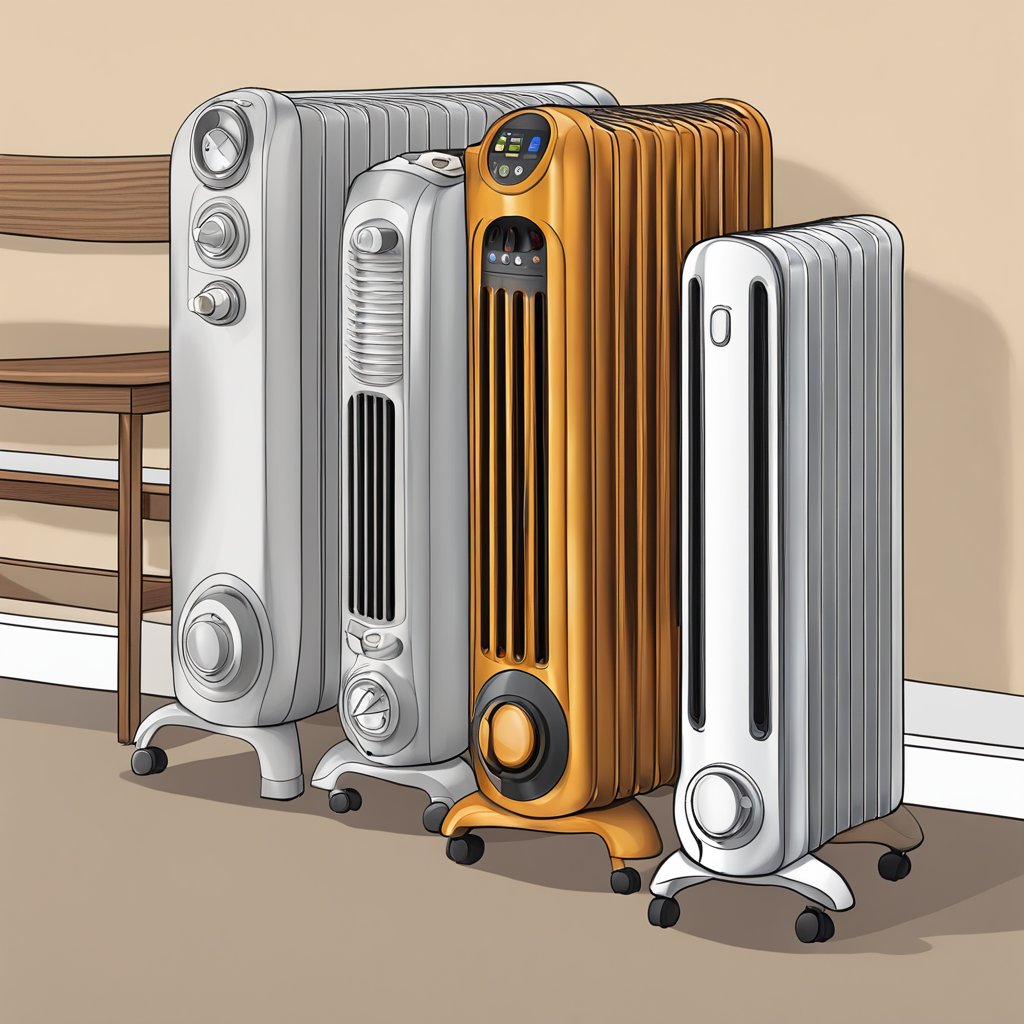
Ceramic Heaters
Ceramic heaters employ a ceramic heating element, which heats up quickly when electricity passes through it. A fan within the heater then blows the warm air from the ceramic element into the room. This allows the ceramic heaters to provide instant heating.
Aspects of ceramic heaters include:
- They offer fast heating and can direct heat in specific directions using a fan.
- They are lighter and more portable compared to oil-filled heaters.
- They might be slightly noisier due to the fan operation.
- They are more suitable for heating smaller spaces or providing targeted warmth.
Keep the characteristics of your desired heater in mind when choosing between an oil-filled and ceramic heater. Consider factors like the size of the space, the amount of time you’ll be using the heater, and your preferred heating speed.
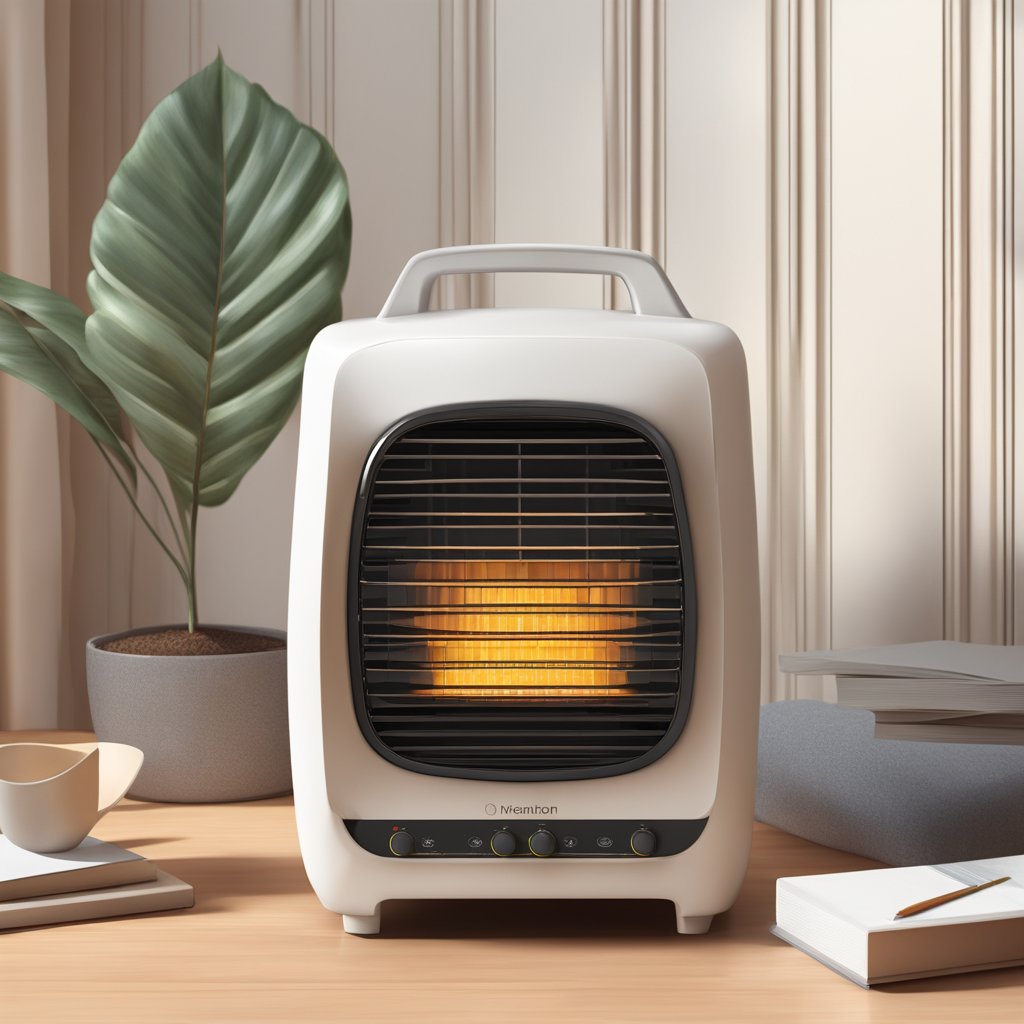
Oil-Filled Space Heaters vs Ceramic Space Heaters – In-depth Comparison
When choosing between oil-filled and ceramic heaters, there are key differences to consider, such as their size, energy efficiency, noise levels, portability, and overall performance.
Size and Portability Differences
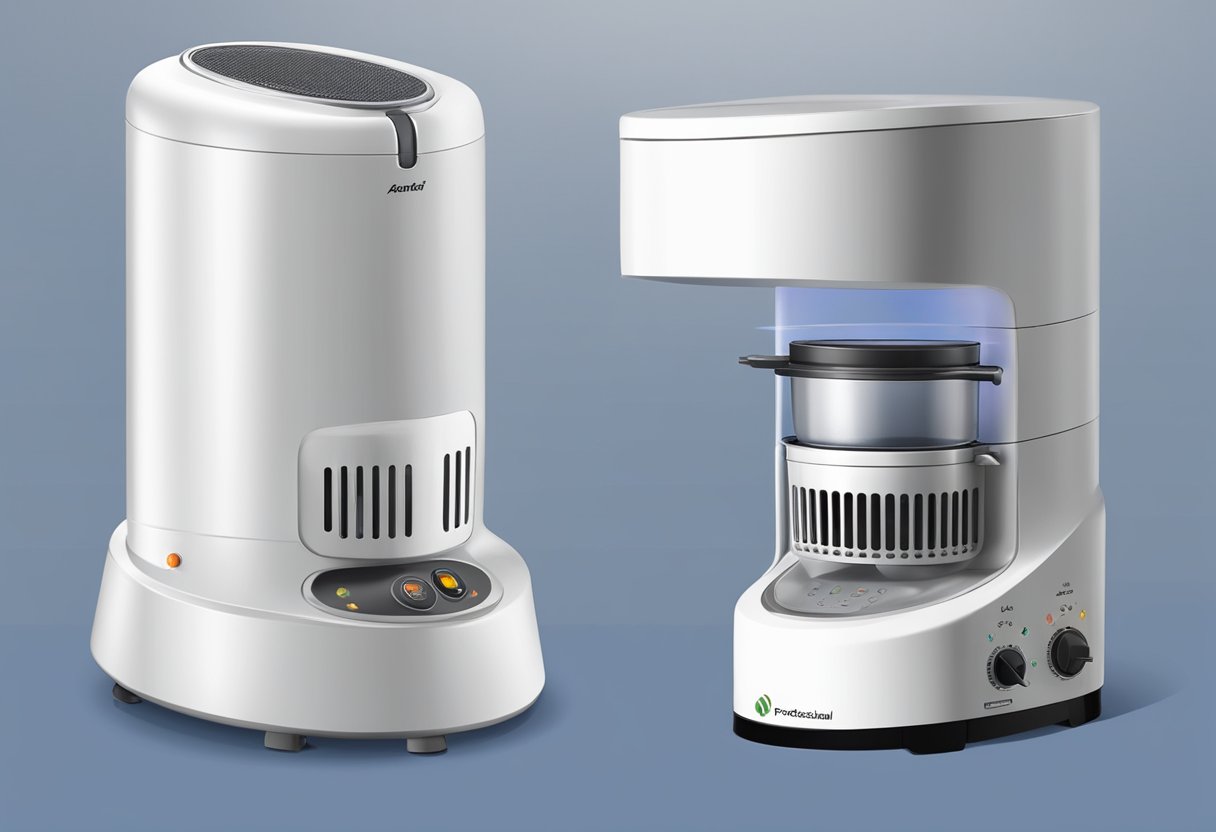
When considering oil-filled heaters and ceramic heaters, one noticeable difference is their size and portability. Ceramic heaters are generally lighter and more compact, making it easier for you to move them from room to room. They usually weigh between 3.5 to 5.9 pounds, with relatively smaller dimensions.
On the other hand, oil-filled heaters are heavier and bulkier due to the oil enclosed within them. They typically weigh between 16 and 23 pounds, making them less convenient to transport. However, many oil-filled heaters come with built-in wheels to assist you in moving them around your space, making up for their increased weight.
Below is a comparison table of typical weights and dimensions for ceramic and oil-filled heaters:
| Heater Type | Weight Range (pounds) | Dimensions (inches) |
|---|---|---|
| Ceramic | 3.5 – 5.9 | Compact |
| Oil-filled | 16 – 23 | Bulky |
When choosing between the two types of heaters, consider your requirements for portability and ease of movement. If you plan to frequently move the heater between rooms, a lightweight ceramic heater may be a better fit for you. However, if you intend to use the heater in a more static location, an oil-filled heater with wheels can provide a practical solution.
Remember to carefully compare each heater’s dimensions and weight to ensure it meets your specific needs in terms of size and portability.
Price and Overall Cost Differences
When comparing oil-filled heaters and ceramic heaters, it’s essential to consider their cost and energy savings potential.
Initial Costs:
Ceramic heaters are generally more affordable than oil-filled heaters. Their simple design and smaller size typically lead to lower manufacturing and retail prices. However, oil-filled heaters provide more even heating and can be a better long-term investment, particularly for larger spaces.
Operating Costs:
Ceramic heaters tend to have lower operating costs. Since they heat up quickly, you only need to run them for a short time to achieve the desired temperature.
Oil-filled heaters, while slower to warm up, may need to operate for longer periods to maintain the heat in a space. This can result in higher energy bills, especially in poorly insulated rooms.
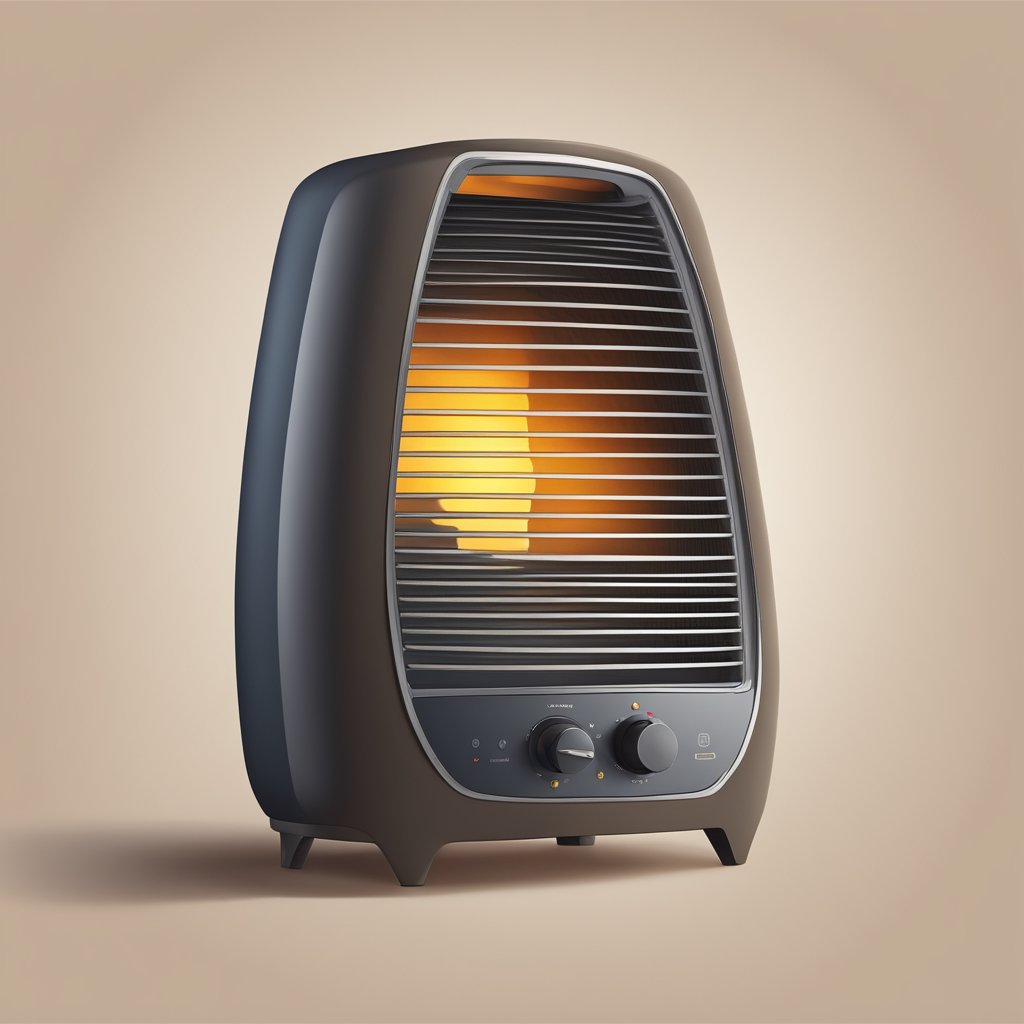
Maintenance Costs:
Oil-filled heaters require minimal maintenance and have fewer moving parts, reducing the risk of failure and need for repairs. Ceramic heaters may need occasional cleaning or component replacement to maintain optimal performance.
In summary, when considering price and energy savings, ceramic heaters have lower initial costs and tend to be more energy-efficient compared to oil-filled heaters. However, the choice between both types of heaters ultimately depends on your specific heating needs and preferences.
Efficiency Differences
When comparing oil-filled and ceramic heaters, it is essential to evaluate their efficiency. Let’s explore their differences in energy efficiency and how each type functions as an efficient room heater.
Oil-filled heaters are generally more energy-efficient compared to ceramic heaters. They operate by heating the oil contained within the unit, which then transfers heat to the room. Once the oil reaches the desired temperature, the heater maintains the heat for an extended period, even after being turned off. This means less energy is needed to keep the heater running.
Ceramic heaters use ceramic plates to generate heat. They typically consume more energy when warming up, but once the unit achieves the desired temperature, the heating element reduces its power usage. Some ceramic heaters also have a fan to distribute heat, resulting in faster heating of a small space. However, the fan can consume extra energy.
Here are some points to consider when comparing the efficiency of oil-filled and ceramic heaters:
- Heat Retention: Oil-filled heaters can retain heat for longer after switching off, making them more efficient in maintaining a consistent room temperature.
- Heating Speed: Ceramic heaters with a fan can heat small spaces quicker due to better heat distribution. However, oil-filled heaters might be more suitable for medium to large rooms.
- Power Consumption: Oil-filled heaters consume less energy in the long run and may be a more cost-effective option if you require long-term heating.
In conclusion, both oil-filled and ceramic heaters have their merits in terms of efficiency. It is essential to consider the size of the room and the duration of use to determine which type of heater best suits your needs.
Maintenance and Durability Differences
Oil-Filled Heaters:
Lifespan: With proper care, oil-filled heaters can last between 8 to 10 years or even more.
Maintenance Tips:
- Dust Removal: Periodically wipe the heater’s surface with a soft cloth to remove dust. Dust can act as an insulator and reduce heating efficiency.
- Check for Leaks: Although rare, always check the heater for any oil leakage, especially if you notice a decrease in heating efficiency.
- Cord Inspection: Examine the power cord for any wear or damage. Damaged cords can be a fire risk.
Common Issues and Troubleshooting:
- Reduced Heating: If the heater is not providing enough warmth, ensure it’s not covered in dust or placed near open windows or doors.
- Strange Noises: Occasional cracking or popping sounds are normal as the oil heats. If you hear consistent unusual noises, consult the manufacturer or a technician.
Ceramic Heaters:
Lifespan: Ceramic heaters generally last about 3 to 5 years with regular use, though the ceramic plates may degrade over time, affecting efficiency.
Maintenance Tips:
- Clean Air Vents: Ensure the air vents are clear of dust or debris. Use a vacuum with a brush attachment or a can of compressed air for cleaning.
- Plate Inspection: Occasionally inspect the ceramic plates for cracks or wear.
- Fan Maintenance: If your heater has a fan, ensure it’s free of dust. A clogged fan can reduce the heater’s efficiency and become a fire hazard.
Common Issues and Troubleshooting:
- Not Heating: Ensure the thermostat setting is correct. If the heater is still not working, the ceramic plates might be damaged.
- Fan Noise: If the fan is noisier than usual, it might be clogged with dust or debris, or the bearings might be wearing out. Consider cleaning or replacement.
Differences in Standard Space Heater Safety Features
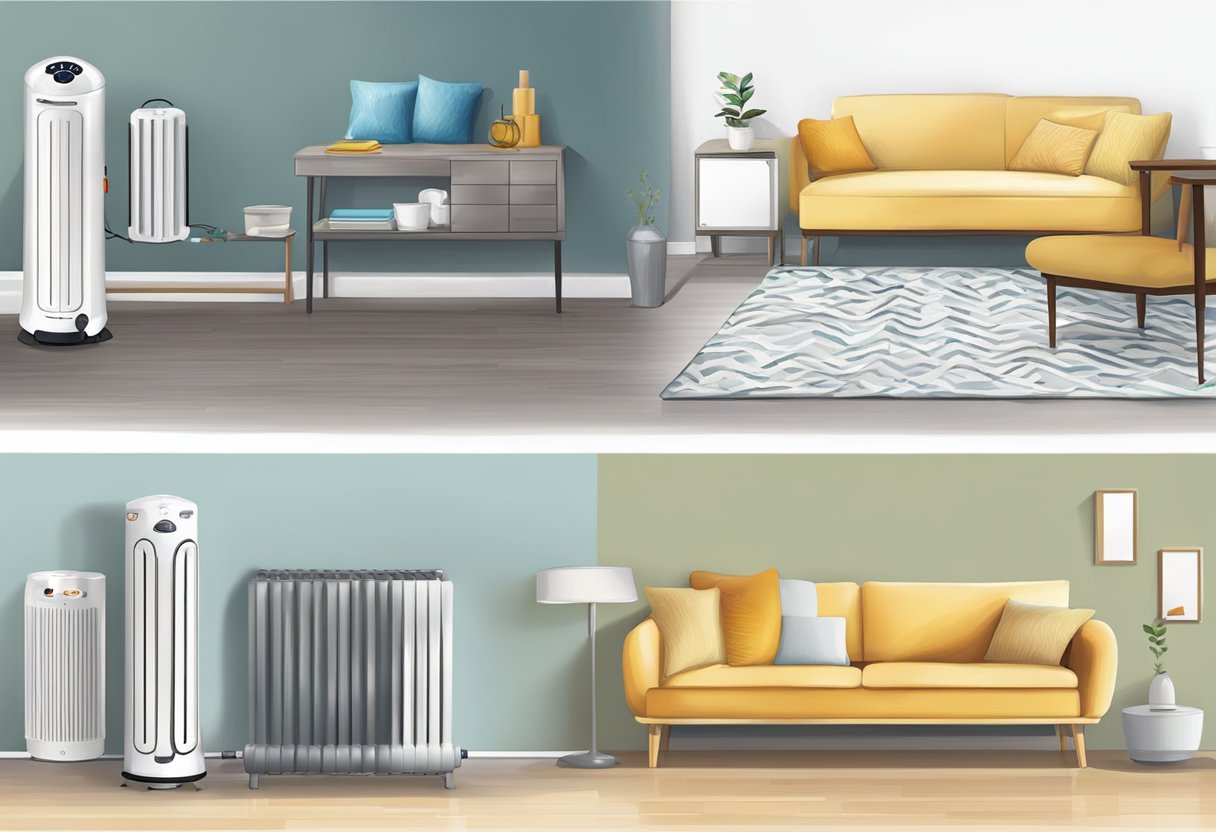
When it comes to safety features of both oil-filled and ceramic heaters, you should ensure that they are UL-certified and come with overheat protection, anti-tip protection, and automatic shut-off. These safety features will prevent accidents and reduce the risk of fires in your home.
Regarding overheating, oil-filled heaters are more energy-efficient as they shut off once the oil reaches a certain temperature, keeping the room warm for up to thirty minutes. On the other hand, ceramic heaters work differently and might require more attention since they provide instant heat and are often used for targeted spot heating.
Oil-filled heaters are generally safer to touch than ceramic heaters. The case around most ceramic heaters doesn’t get too hot, reducing the chance of burns. However, it is still essential to exercise caution with the heater placement, especially if you have small children or pets around.
Here are some safety tips to follow:
- Place the heater on a flat and stable surface.
- Keep the heater away from flammable materials and substances.
- Do not cover the heater or block its vents.
- Unplug the heater when it is not in use.
- Install a smoke detector and carbon monoxide detector in your home.
- Regularly inspect your heater for damage or wear and replace it if necessary.
Remember to use only one plug per outlet for your heater to avoid overloading the electrical circuit and increasing fire risks. By following these guidelines, you can maintain the safety and efficiency of your oil-filled or ceramic heater.
Noise Level Differences
One major advantage of oil-filled heaters is that they are generally quieter, as they do not rely on fans to distribute heat.
Ceramic heaters usually incorporate fans to circulate heated air, which can generate noise. If you prefer a silent heating option, oil-filled heaters might be more suitable.
Performance in Different Room Sizes
In large spaces, oil heaters may provide more consistent heating due to their ability to maintain temperature over time. Their radiant heat is a more gradual process, which is better suited for large rooms. On the other hand, ceramic heaters can heat spaces more rapidly, making them great for quickly warming up small rooms.
When deciding between an oil-filled heater and a ceramic heater, it’s important to consider your specific needs and preferences.
Keep in mind the characteristics of each type of heater, such as size, efficiency, noise, portability, and performance in different room sizes, to make the most appropriate choice for your situation.
Choosing Between Oil Filled and Ceramic Heaters
When you’re deciding between oil-filled and ceramic heaters, it’s essential to consider the primary heating needs for your space.
Space Heaters for Smaller Spaces
If you’re looking for a heater suitable for smaller spaces, like a bedroom or office, a ceramic space heater would be an excellent choice. These heaters use ceramic plates to heat up quickly and provide warm air in a matter of minutes.
Many ceramic space heaters also include an oscillation feature, which helps to distribute warm air evenly throughout the room. This type of heater is great for spot-heating and can efficiently warm up a cold corner in about 15 minutes.
However, consider your allergies and sensitivity to dry air, as ceramic heaters can lower humidity levels in smaller spaces.
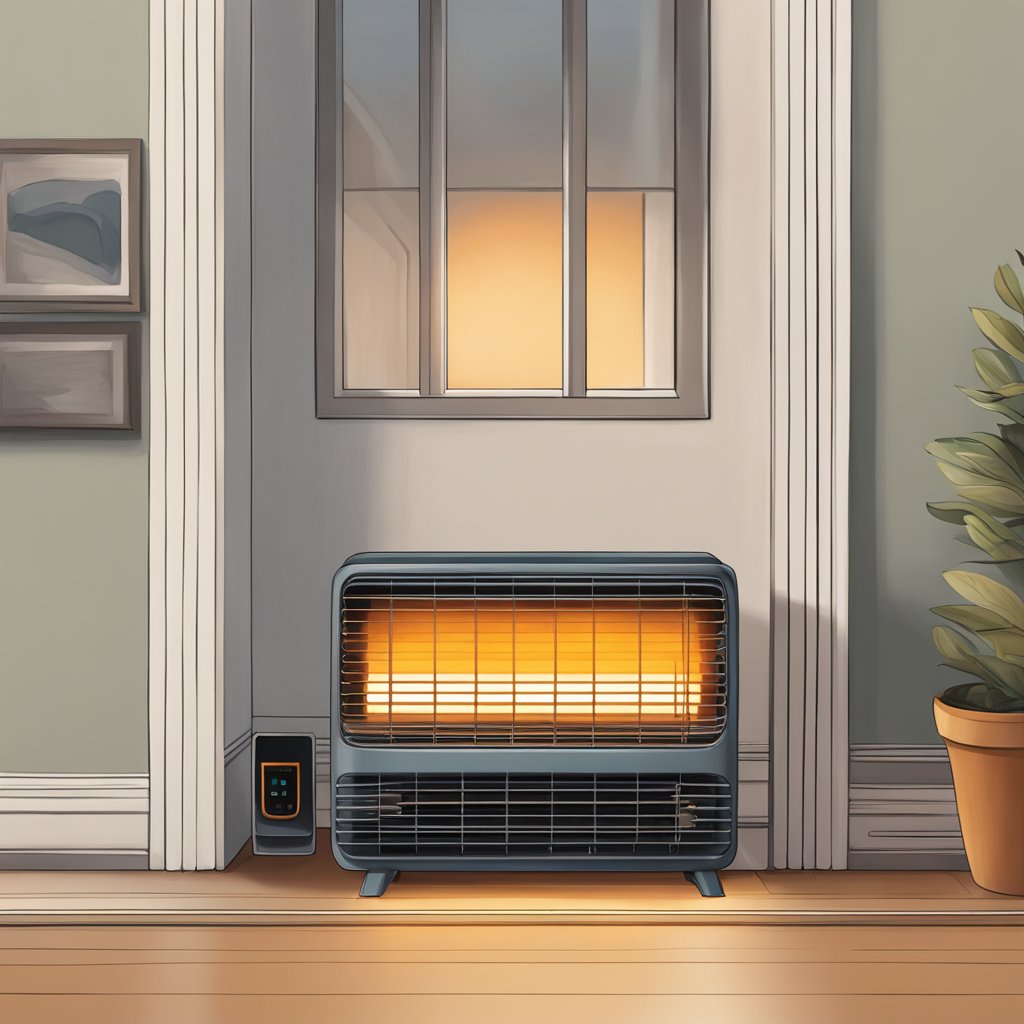
Space Heaters for Larger Rooms
For larger rooms, an oil-filled space heater is a more effective option. These heaters use metal fins filled with oil to provide gentle, consistent warmth throughout the space.
Oil-filled heaters take longer to warm up compared to ceramic heaters but maintain a comfortable temperature for an extended duration. They’re also energy-efficient, which is ideal for heating larger spaces without increasing your energy bills significantly.
Additionally, oil-filled space heaters do not decrease humidity levels and have no impact on allergies.
Features to consider when choosing a heater for larger rooms:
- Energy efficiency: Oil-filled heaters use less energy in maintaining consistent warmth.
- Humidity: Oil-filled heaters don’t lower humidity levels like ceramic heaters, making them allergy-friendly.
- Warm-up time: Oil-filled heaters take longer to warm up but provide long-lasting comfort.
To sum up, your choice between oil-filled and ceramic heaters depends on the size of the space you need to heat, your energy efficiency preferences, and the desired noise level. Choose a ceramic heater for rapid, targeted heating in smaller spaces, and an oil-filled heater for consistent warmth in larger areas.
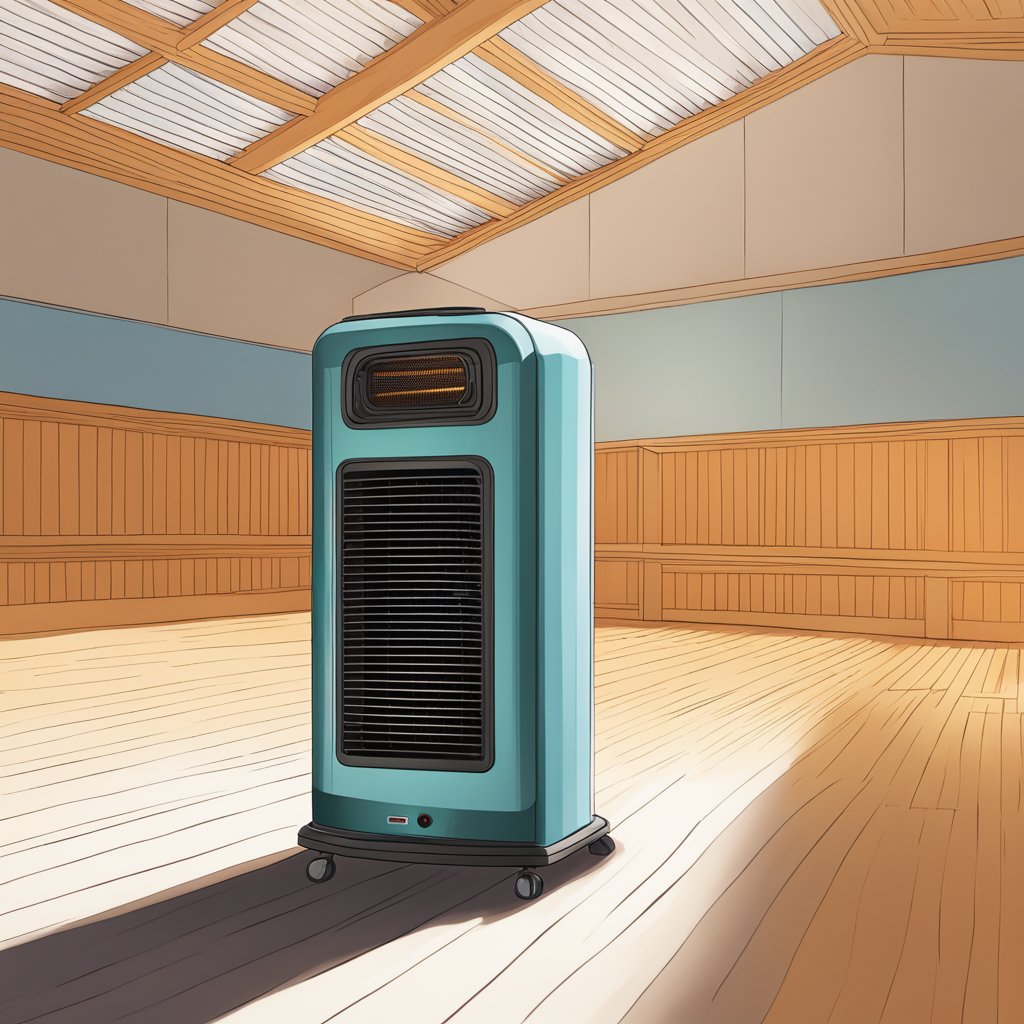
Check Out Our Complete Guide to Space Heaters!
If you enjoyed this post, check out our complete guide to space heaters for more information on space heater types, safety features, troubleshooting common issues, and how to choose the right space heater for your needs!
Let Us Know How We’re Doing!
Did this expertly prepared resource answer your question?
Do you have another question about home maintenance, home improvement projects, home appliance repair, or something else?
Get more information, send in questions and keep the discussion going by contacting the I’ll Just Fix It Myself company customer service team at at 1-800-928-1490 or Email us at [email protected]
